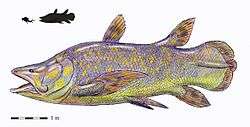Mawsonia (fish)
| Mawsonia Temporal range: Late Cretaceous, 110–95 Ma | |
|---|---|
 | |
| skull | |
| Scientific classification | |
| Kingdom: | Animalia |
| Phylum: | Chordata |
| Class: | Sarcopterygii |
| Order: | Coelacanthiformes |
| Family: | †Mawsoniidae |
| Genus: | †Mawsonia Woodward, 1907 |
| Species | |
| |
Mawsonia is an extinct genus of prehistoric coelacanth fish, and the largest of this group, up to several meters long.[1] It lived during the Cretaceous period (Albian and Cenomanian stages, about 99 to 112 million years ago). Fossils have been found in Africa and South America. Mawsonia was first described by British palaeontologist Arthur Smith Woodward in 1907.
Description

Artists impression of Mawsonia.
Mawsonia was a large coelacanth which lived in what is now the Kem Kem Beds and Bahariya Formation in North Africa, during the Cretaceous. Mawsonia was around 4–6 meters in length, around the size of a rhinoceros. Like modern coelacanths, Mawsonia was possibly an opportunistic carnivore that could have eaten fish and large invertebrates.[2]
References
External links
Sources
- Fishes of the World by Joseph S. Nelson
- History of the Coelacanth Fishes by Peter Forey
- Discovering Fossil Fishes by John Maisey and John G. Maisey
- A Pictorial Guide to Fossils by Gerard Ramon Case
- The Lost Dinosaurs of Egypt by William Nothdurft and Josh Smith
- Famous Dinosaurs of Africa by Anusuya Chinsamy-Turan
- The Rise of Fishes: 500 Million Years of Evolution by John A. Long
- Evolution of Fossil Ecosystems by Paul Selden and John Nudds
This article is issued from Wikipedia - version of the 9/3/2016. The text is available under the Creative Commons Attribution/Share Alike but additional terms may apply for the media files.